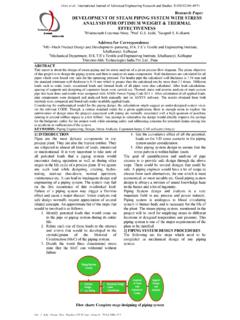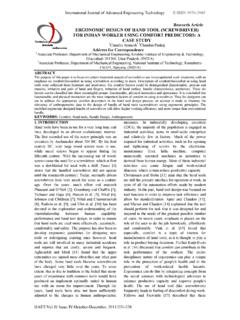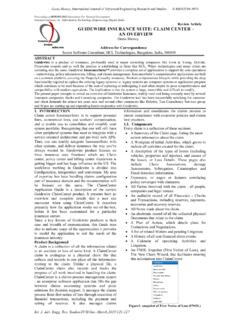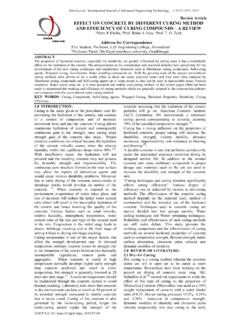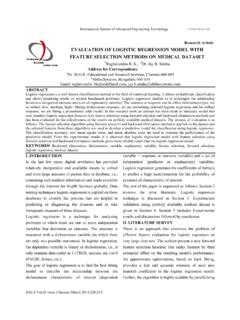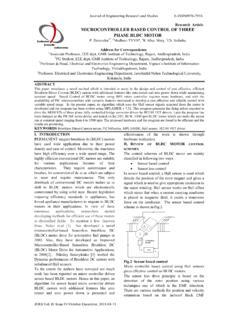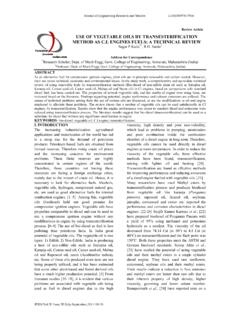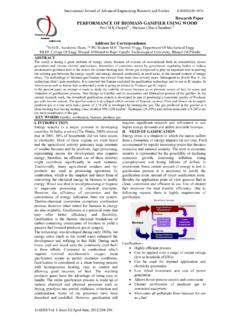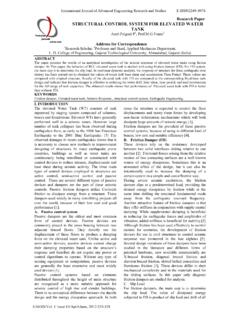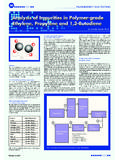Transcription of Review Article “EFFECT OF EXHAUST GAS …
1 International Journal of Advanced Engineering Research and Studies E-ISSN2249 8974 IJAERS/Vol. I/ Issue III/April-June, 2012/223-227 Review Article EFFECT OF EXHAUST GAS RECIRCULATION (EGR) ON NOx EMISSION FROM ENGINE - A Review STUDY Harilal S. Sorathia* , Dr. Pravin P. Rahhod and Arvind S. Sorathiya Address for Correspondence Department of Mechanical Engineering, Government Engineering College, Bhuj Kutch, Gujarat 370 001 ABSTRACT Internal combustion engines are established as the main power source for the automobile vehicles.
2 At present emission norms becomes strict for any Engine. The main pollutant are CO, HC, NOx, PM, soot, etc from which NOx are one of the most harmful component. It is possible to limit the negative effect of NOx on the environment by various methods like EXHAUST gas recirculation (EGR), catalyst and water injection. The aim of this work is to Review the effect of EXHAUST gas recirculation (EGR) to reduce the NOx emission from tailpipe of homogeneous charged Cooled EXHAUST gas recirculation (EGR) is a common way to control the NOx generation in engine cylinder. It was found that adding EGR to the fresh air charge to homogeneous charged engines will beneficial to reduce the NOx emission substantially.
3 Substantial reductions in NOx emission are achieved by previous investigators with 10% to 30% EGR. However, EGR has other effects on combustion and emission production that are increase of intake charge temperature, delay in heat release, decrease of peak cylinder temperature and decrease in O2 concentration in cylinder charge and decrease the air-fuel ratio. KEY WORDS Diesel Engine, Bio-Diesel, Biogas, Hydrogen, LPG, EGR, Dual-Fuel, CO, HC, NOx, PM, soot, etc. I. INTRODUCTION Air pollution can be defined as an addition of any material to the atmosphere which will have threatening effects on existence of mankind.
4 In recent year due to globalization and industrial development, transportation industries are flourishing very fast. Such industries are very much responsible for atmospheric pollution which is detrimental to human health and environment. Internal combustion engines are the main power source for the automobile vehicles which is used by transportation industries. Mostly all the diesel engines have high thermal efficiencies because of their high compression ratio and lean air-fuel operation. The high compression ratio produces the high temperatures required to achieve auto ignition and the resulting high expansion ratio makes the engine discharge less thermal energy in the EXHAUST .
5 Due to lean air-fuel mixture, extra oxygen in the cylinders is present to facilitate complete combustion [1, 12]. Increasing diesel consumption increases the pollutant that pollutes the atmospheric air [12]. Thus good efforts are being made to reduce the pollutants emitted from the EXHAUST system without loss of power and fuel consumption [1, 12]. Recent concern over development in automotive technology is the low environmental impact. In fact, partial recirculation of EXHAUST gas, which is not a new technique, has recently become essential, in combination with other techniques for attaining lower emission levels.
6 Several reasons can be used to explain for this interest. The proposal of the future Bharat Stages directive establishes separate and even more stringent limits for NOX emissions. The reductions in NOX emissions have probably become the most difficult target to attain, owing to the associated reverse effect of other recently used techniques, such as high supercharging, an improved mixing process by more efficient injection systems etc. The development of a new generation of EXHAUST gas recirculation (EGR) valves and improvements in electronic controls allow a better EGR accuracy and shorter response time in transient conditions.
7 The most common operating conditions, mainly the passenger cars are operating at lower engine loads in urban font density, and it must be considered that it is mainly at partial loads where EGR is indicated because of its higher oxygen content. Pollutants are because of the incomplete burning of the air-fuel mixture in the combustion chamber. The major pollutants emitted from the EXHAUST due to incomplete combustion are [12], 1. Carbon monoxide (CO) 2. Hydrocarbons (HC) 3. Oxides of nitrogen (NOx) If, combustion is complete, the only products being expelled from EXHAUST would be water vapour which is harmless, and carbon dioxide, which is an inert gas and, as such it is not directly harmful to humans.
8 II. MECHANNISM OF FORMATION OF POLLUTANT A. Mechanism of formation of Carbon Monoxide (CO) Carbon monoxide is a colourless poisonous gas. Small amounts of CO concentrations, when breathed in, slow down physical and mental activity and produces headaches, while large concentration will kill. CO is generally formed when the mixture is rich in fuel. The amount of CO formation increases as the mixture becomes more and more rich in fuel. A small amount of CO will come out of the EXHAUST even when the mixture is slightly lean in fuel because air- fuel mixture is not homogenous and equilibrium is not established when the products pass to the EXHAUST .
9 At the high temperature developed during the combustion, the products formed are unstable and following reactions take place before the equilibrium is established [12]. 2C+O2 = 2CO As the products cool down to EXHAUST temperature, major part of CO reacts with oxygen to form CO2. However, a relatively small amount of CO will remain in EXHAUST . B. Mechanism of formation of Hydrocarbons (HC) Hydrocarbons, derived from unburnt fuel emitted by exhausts, engine crankcase fumes and vapour escaping from the carburetor are also harmful to health. Hydrocarbons appears in EXHAUST gas due to International Journal of Advanced Engineering Research and Studies E-ISSN2249 8974 IJAERS/Vol.
10 I/ Issue III/April-June, 2012/ local rich mixture pockets at much lower temperature than the combustion chamber and due to flame quenching near the metallic walls. A significant amount of this unburnt HC may burn during expansion and EXHAUST strokes if oxygen concentration and EXHAUST temperature is suitable for complete oxidation [12]. C. Mechanism of formation of nitric oxide (NO) Oxides of nitrogen is produced in very small quantities can cause pollution. While prolonged exposure of oxides of nitrogen is dangerous to health. Oxides of nitrogen which occurs only in the engine EXHAUST are a combination of nitric oxide (NO) and nitrogen dioxide (NO2).

